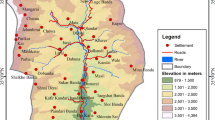Abstract
The landslides in northern Pakistan are mainly occurring on Karakoram Highway, Swat, Kaghan, Neelum, and Jhelum valleys, Murree and Galiat areas. Galiat region forms the southern part of outer or sub-Himalayas. For such larger study areas having inherent geotechnical variability and inhomogeneity, coupled with high costs of investigations, the exclusive use of either deterministic or probabilistic approach has never remained valid. This study resulted in the development of the Slope Failure Potential (SFP) maps and provision of recommendations for the mitigation of landslides in Murree and Galiat area. The objectives were achieved through extensive field and laboratory investigations program, numerical and statistical modeling, and generation of fuzzy logic based computer models. In this study, we used both deterministic geotechnical and geophysical field and laboratory investigations to augment the probabilistic landslide hazard assessment using Fuzzy logic concept. The resulting SFP maps demarcated the study routes into different SFP (i.e., very high, high, medium, low, very low) zones under static loading conditions. These maps were intended to be used for the assessment of the landslide hazard and risk analysis for the existing infrastructure and the design of future construction and land use. The validity of the SFP maps was established through the follow-up of the type, nature and the damage associated with the several intensity level landslides occurred at different locations in the study area during the last ten years.
Similar content being viewed by others
References
Akram, T. and Ahmed, H. R. (2006). “Slope stability study of galliat area.” A Research Project Report Presented to Higher Education Commission, Islamabad.
ASTM D4644-08 (2016). Standard Test Method for Slake Durability of Shales and Similar Weak Rocks.
ASTM G57-06 (2012). Standard Test Method for Field Measurement of Soil Resistivity Using the Wenner Four-Electrode Method.
Chi, K., Park, N., and Chung, C. (2002). “Fuzzy Logic Integration for Landslide hazard map** Using Spatial Data from Boeun, Korea” Symposium on Geospatial Theory, Processing, and Applications, Ottawa, 2002.
Flentje, P. and Chowdhury, R. (2001). A focus on hilly areas subject to the occurrence and effects of landslides, International Workshop on Disaster Reduction August 2001.
Gohar, S. H. (1987). Lithostructural Map** and Geology of Bara Gali–Kundla Area, Master’s Thesis, Division of Petroleum Geology, Institute of Geology, University of the Punjab, Lahore.
GSP (2000). “Geologic map of pakistan.” Map Series 1233-2000, Geological Survey of Pakistan, Quetta.
Harden, I. and Viberg, L. (1988). “General report: Evaluation of landslide hazard,” In Proc., Fifth International Symposium on Landslides, Lausanne (C. Bonnard, ed.), A.A. Balkema, Rotterdam, Netherlands, Vol. 2, pp. 1037–1057.
Ishfaq, M. (2005). GIS in landslides susceptibility map**, murree area, North Pakistan, 25th ESRI International User Conference, 2005, San Diego, California.
Jawaid, S. M. A. (2000). Risk Assessment of Landslide Using Fuzzy Theory, Landslides: In Research, Theory, and Practice. Proceedings of the 8th International Symposium on Landslides, Cardiff, Thomas Telford, ASCE, VA.
Juang, C. H., Lee, D. H., and Sheu, C. (1992). “Map** slope failure potential using fuzzy sets,” Journal of Geotechnical Engineering ASCE, Vol. 118, No. 3, pp. 475–493, DOI: 10.1061/(asce)0733-9410 (1992)118:3(475).
Khan, K. S. A., Fayaz, A., Latif, M., and Khan, M. S. (1987). Study of Landslide Problems along the Rawalpindi-Murree-Kohala Road (Kashmir Highway), Information Release No.279, Geological Survey of Pakistan.
Lee, D. and Juang, C. H. (1992). “Evaluation of failure potential in mudstones slopes using fuzzy sets.” Proceedings of the Specialty Conference, Stability, and Performance of Slopes and Embankments-II, sponsored by Geotechnical Engineering Division, American Society of Civil Engineers, New York, DOI: 10.1016/0148-9062(94)92703-0.
Mulder, H. F. H. M. (1991). Assessment of landslide hazard, PhD Thesis, University of Utrecht, Netherlands.
Mulder, H. F. H. M. and Vanasch, T. W. J. (1988). “A stochastical approach to landslide hazard determination in a forested area” Proc. Fifth International Symposium on Landslides, Lausanne (C. Bonnard, ed.), A.A. Balkema, Rotterdam, Netherlands, Vol. 2, pp. 207–1210.
Peltier, L. C. (1950). “The geographic cycle in periglacial regions as it is related to climatic geomorphology,” Annals of Association of American Geographer, Vol. 40, pp. 214–236, DOI: 10.1080/00045605009352070.
Rajasekaran, S. and Vijayalakshami, G. A. (2004). “Neural networks, fuzzy logic, and genetic algorithms: Synthesis and applications.” Prentice-Hall of India Private Limited, New Delhi. SIGMA/W: ver 4.1 by Geoslope International Surfer version 7, Golden Software Company, USA.
Tangestani, M. H. (2000). “Landslide Susceptibility map** using the fuzzy gamma operation in a GIS, Kakan Catchment Area, Iran” www.gisdevelopement.net, DOI: 10.1111/j.1400-0952.2004.01068.x.
Turner, A. K. and Schuster, R. L. (1996). “Landslides: Investigation and Mitigation.” Special Report 247, Transportation Research Board, National Research Council, National Academy Press, Washington, D.C.
United Nations University, Tokyo (2006}). Newsletter: International Network of Research and Training Centers/Programmes. Issue 40: November 2005-February 2006. http://update.unu.edu/issue40_10.htm
Varnes, D. J. (1984). “Hazard zonation: A review of principle and practice,” Commission of Landslide of IAEG, UNESCO, Natural Hazards, Vol. 3, pp. 61.
Xeu-Cai, F. and An-Ning, G. (1986). “Principal characteristics of earthquake landslides in China,” Geologia Applicata e Idreogeologia (Italy), Vol. 21, No. 2, pp. 27–45.
Zadeh, L. A. (1965). “Fuzzy Sets; IEEE Information and Control.” Vol. 8, pp. 338–353, DOI: 10.1016/s0019-9958(65)90241-x.
Author information
Authors and Affiliations
Corresponding author
Rights and permissions
About this article
Cite this article
Ahmed, H.R., Akram, T. Map** of Slope Failure Potential of Galiat area Pakistan using Fuzzy Logic Concept. KSCE J Civ Eng 22, 1661–1676 (2018). https://doi.org/10.1007/s12205-017-1191-8
Received:
Revised:
Accepted:
Published:
Issue Date:
DOI: https://doi.org/10.1007/s12205-017-1191-8




